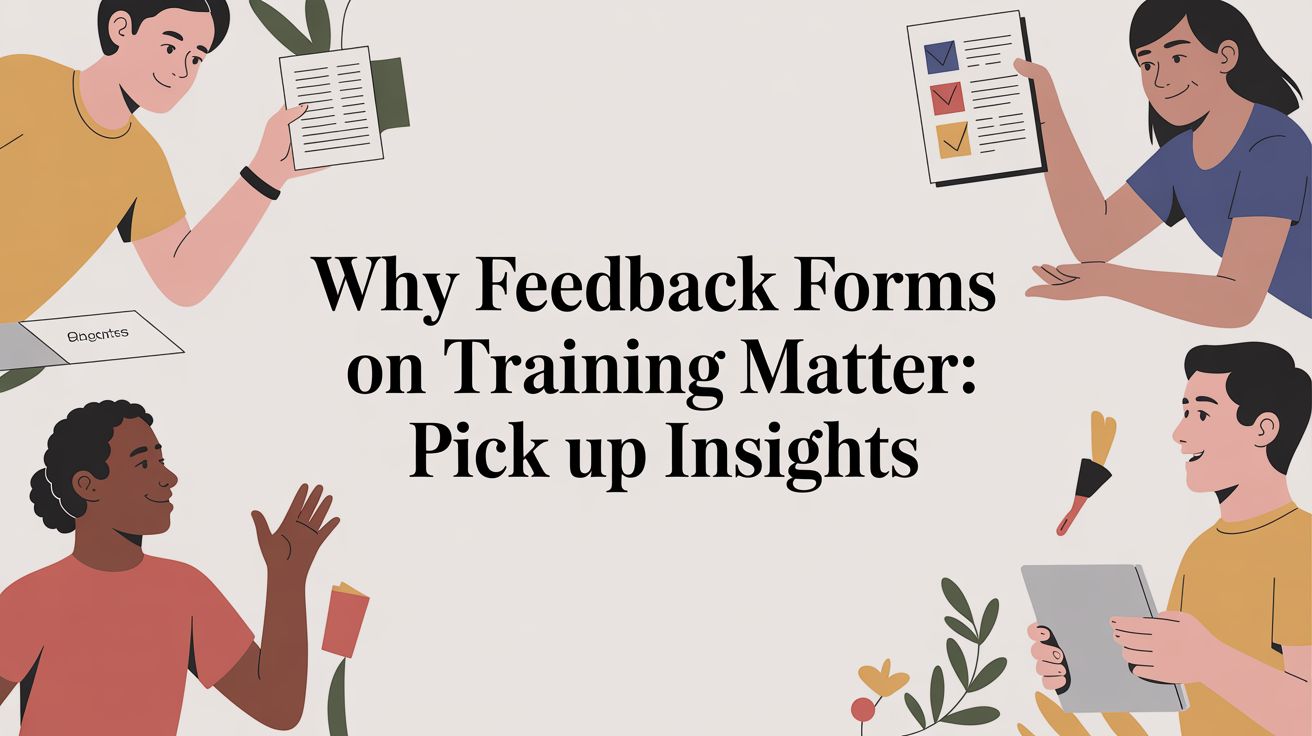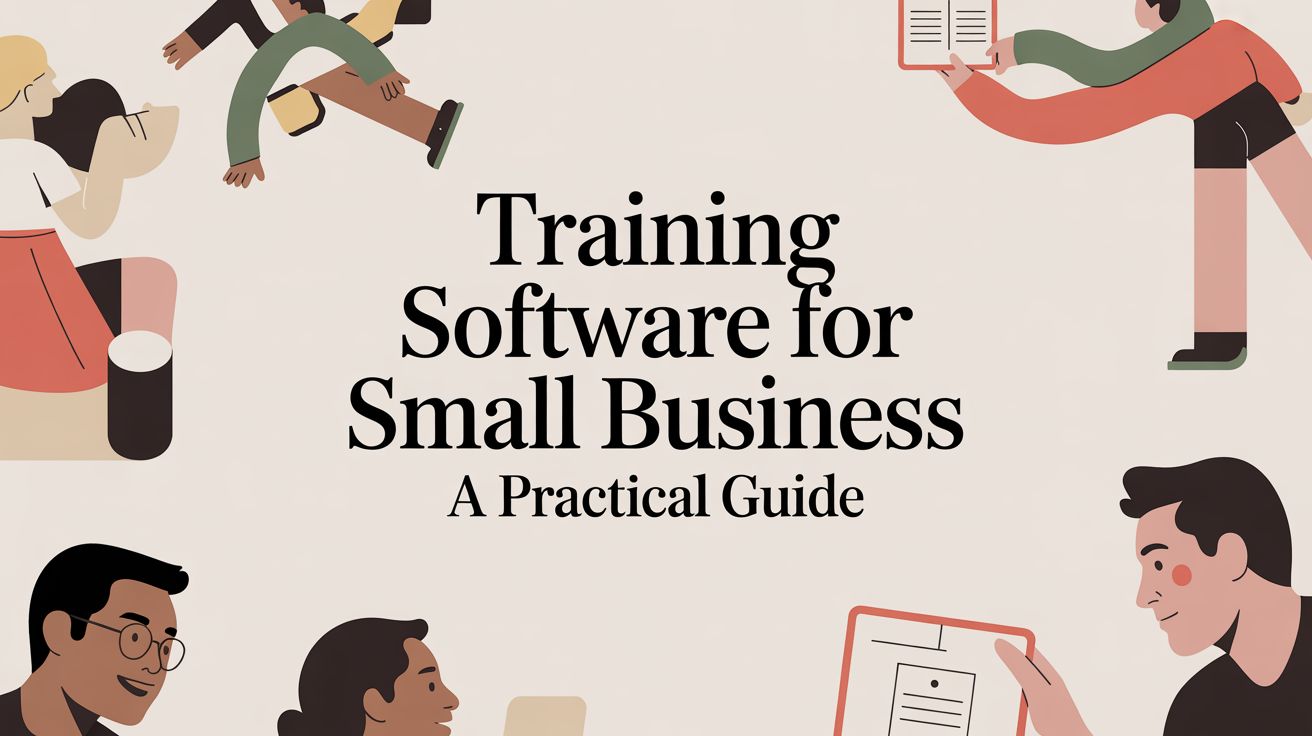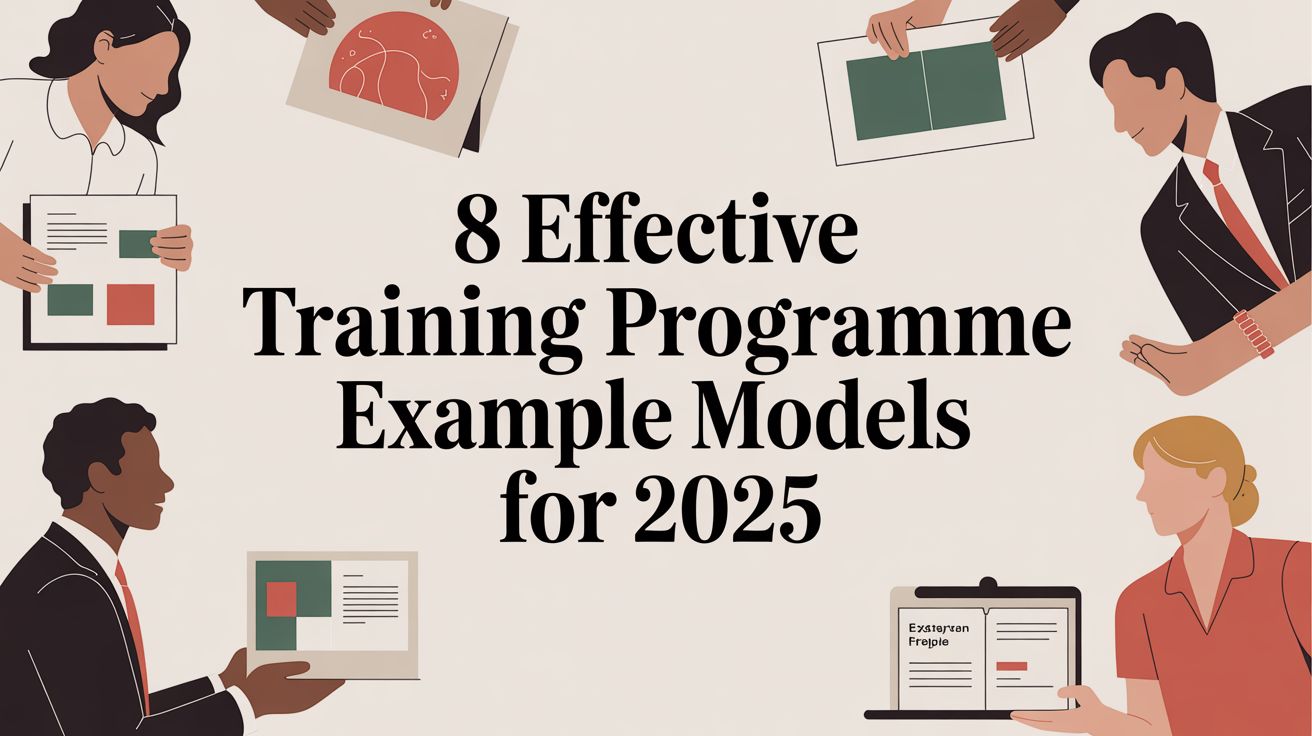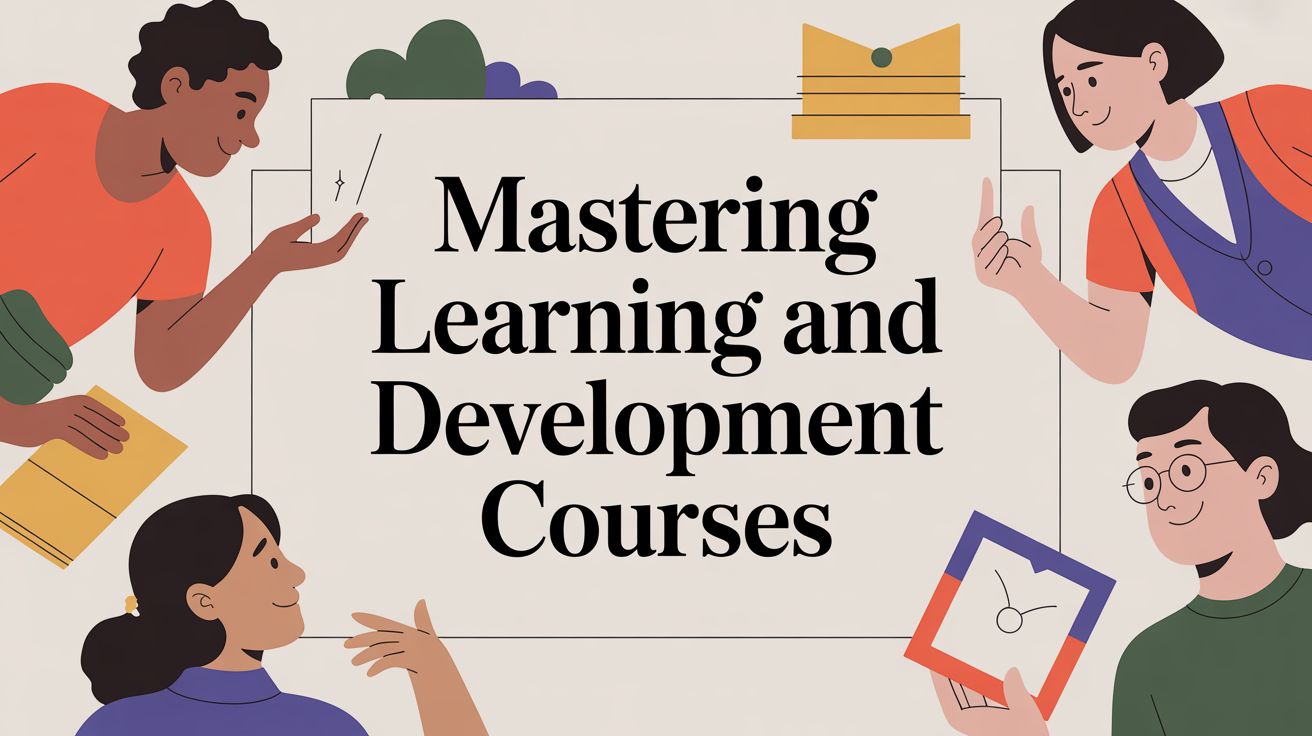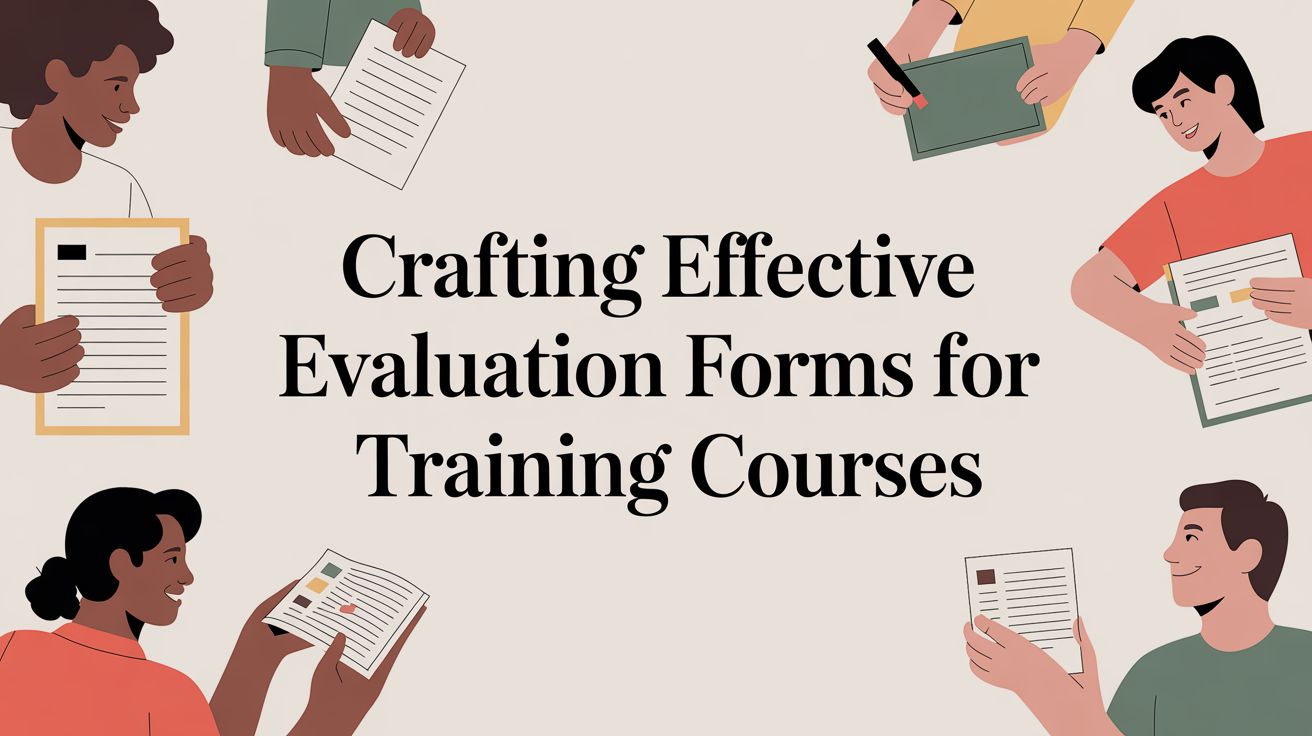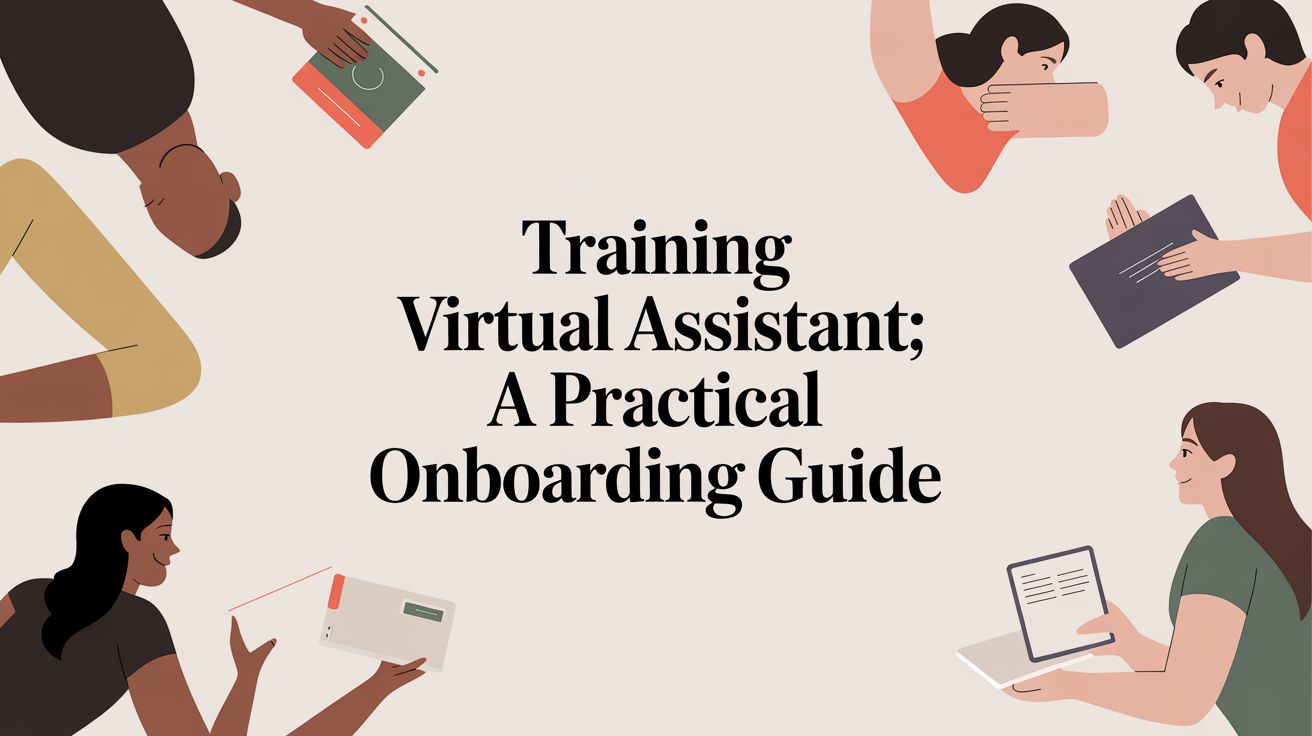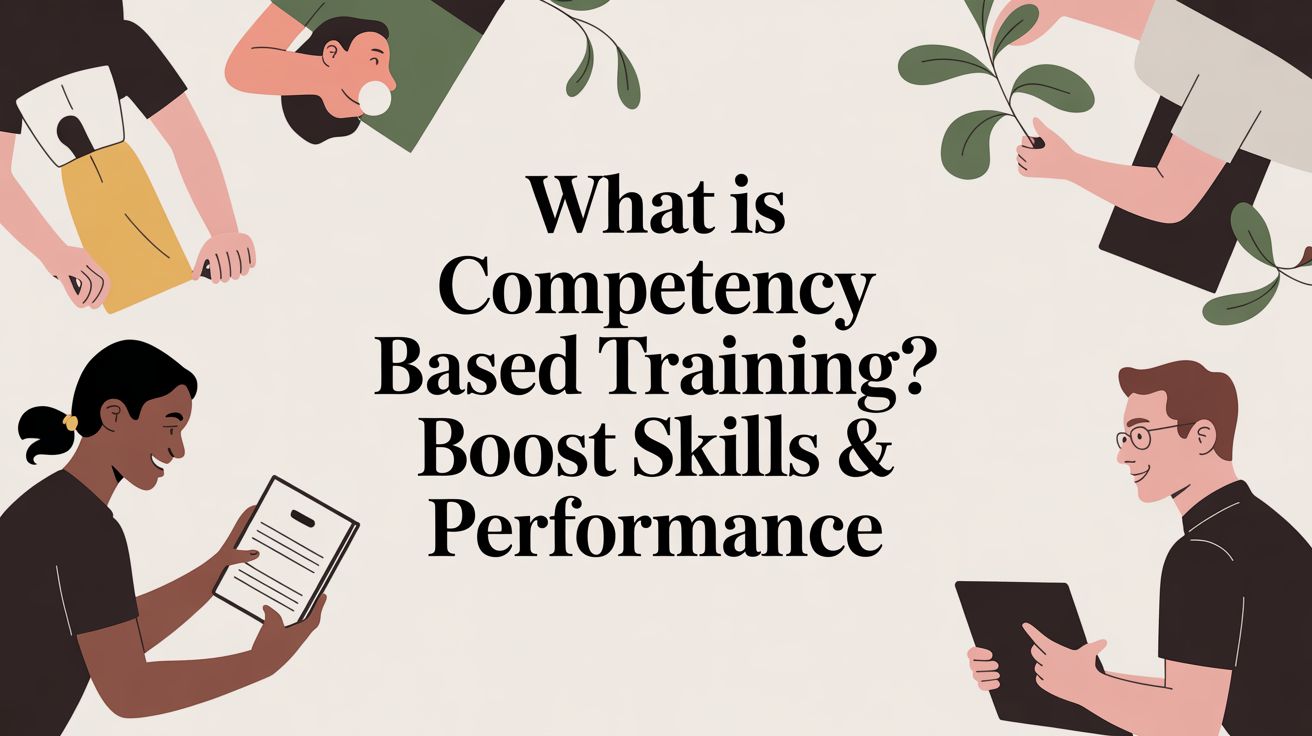8 Essential Course Evaluation Questions to Ask in 2025

In the world of professional training, success isn't just about delivering content; it's about delivering impact. But how can you be certain your instructor-led courses are hitting the mark? The answer lies in asking the right course evaluation questions. Effective feedback is the compass that guides continuous improvement, helping you refine content, empower instructors, and maximize learner outcomes. Moving beyond generic surveys transforms feedback from a routine task into a powerful tool for strategic growth.
This guide breaks down the essential categories of questions you need to ask to gather truly actionable insights. We will provide specific, real-world examples, a strategic analysis of why each question works, and tactical takeaways you can implement immediately. The goal is to equip training managers and administrators with the tools to measure what truly matters.
Key Insight: Actionable feedback is the cornerstone of a successful training program. The quality of your data depends entirely on the quality of your questions.
Whether you're managing face-to-face workshops, virtual classrooms, or complex hybrid sessions, the right questions are critical. They help you pinpoint strengths and uncover areas for improvement with precision. The insights gained from a well-structured evaluation directly inform and enhance every part of your L&D strategy, from instructor development to resource allocation. These evaluations are crucial not just for individual courses, but for the foundational structure of an employee training plan template, ensuring programs are continually refined for excellence.
This listicle will cover eight fundamental areas, including:
- Content Quality and Relevance
- Instructor Effectiveness and Delivery
- Course Organization and Structure
- Clarity of Learning Objectives
- Assessment Methods and Fairness
- Student Engagement and Interaction
- Resources and Technology
- Overall Course Value and Recommendation
Let's dive into the specific course evaluation questions that will help you elevate your training programs to the next level.
1. Content Quality and Relevance
The cornerstone of any effective training program is its content. Course evaluation questions focused on content quality and relevance assess whether the material is accurate, current, well-organized, and directly aligned with the stated learning objectives. This foundational line of inquiry determines if the course is delivering real value and meeting the educational needs of its participants. It’s the first and most critical gate in evaluating a course's overall success.
This evaluation area isn't just a simple satisfaction check; it's a strategic tool. Accreditation bodies like WASC and learning frameworks such as Bloom's Taxonomy have long popularized this focus, ensuring educational standards are met. Today, leading platforms have adapted this principle to stay competitive and effective.
Strategic Breakdown
- University of California System: Utilizes detailed content alignment rubrics where instructional designers and subject matter experts review course materials against learning outcomes before launch. This proactive approach ensures content is purposeful from day one.
- Coursera: Implements an annual content relevance survey, asking learners directly if the material helped them achieve their goals. This direct feedback loop provides actionable data for course updates.
- LinkedIn Learning: Surveys learners on the applicability of content within their professional roles, connecting learning directly to on-the-job performance and career progression.
Actionable Insights & Takeaways
To effectively evaluate your course content, move beyond generic "was this useful?" questions. Instead, adopt a more structured and data-driven methodology. For insights into how to establish and maintain high standards for your educational materials, consider exploring different approaches to content quality assurance.
Here are specific tactics to implement:
- Use a Likert Scale (1-5): Frame specific questions like, "The course content was up-to-date and relevant to my needs," and use a scale from "Strongly Disagree" to "Strongly Agree." This generates quantitative data that is easy to analyze.
- Ask Targeted Follow-up Questions: After a scaled question, ask, "Which topics, if any, felt outdated or were missing?" This qualitative follow-up provides the specific details needed to make precise content improvements.
- Segment Your Feedback: Analyze feedback across different learner cohorts (e.g., by department, experience level, or job role). This can reveal that content is highly relevant for one group but less so for another, allowing for more personalized course adjustments.
Pro Tip: Benchmark your course content against current industry standards and job requirements. This ensures your training remains not just relevant, but also competitive and valuable in the professional marketplace.
2. Instructor Effectiveness and Delivery
An instructor can make or break a learning experience. Course evaluation questions focused on instructor effectiveness and delivery measure how well the facilitator communicates complex topics, engages learners, and creates a supportive learning environment. This line of inquiry assesses everything from subject matter expertise and clarity of explanation to teaching style and the ability to foster participation. It’s a crucial component for understanding whether the human element of training is hitting the mark.
This evaluation area moves beyond simple likeability to provide objective data on teaching performance. Its importance has long been championed by organizations like the American Association of University Professors (AAUP) and pioneers such as William Centra, who helped establish student evaluations as a cornerstone of institutional improvement. Today, leading institutions have refined this process into a powerful strategic tool.
Strategic Breakdown
- Harvard Business School: Employs detailed instructor rubrics that assess specific competencies, such as case method facilitation and the ability to guide class discussions, ensuring a consistent and high-quality teaching standard.
- Duke University: Its ACES (Assessment of Course and Teaching Effectiveness) system gathers structured feedback on multiple dimensions of teaching, allowing for nuanced analysis beyond a single overall rating.
- edX: Leverages learner feedback at scale to identify and recognize top-performing instructors, using data-driven insights to highlight best practices and guide other educators on the platform.
Actionable Insights & Takeaways
To accurately gauge instructor performance, you need to dissect the different facets of their role. A single "rate the instructor" question is insufficient. For a deeper understanding of how instructor performance connects with various teaching formats, explore different delivery methods in training and how they can be evaluated.
Here are specific tactics to implement:
- Measure Multiple Dimensions: Use separate Likert-scale questions for distinct skills. For example: "The instructor explained concepts clearly," "The instructor encouraged questions and participation," and "The instructor demonstrated deep knowledge of the subject."
- Ask Specific Behavioral Questions: Instead of a vague question like "Was the instructor engaging?", ask, "Did the instructor use relevant examples and activities to hold your attention?" This focuses feedback on observable actions.
- Separate Content from Delivery: Include questions that distinguish the instructor's teaching ability from the quality of the course material itself. An instructor might be excellent at delivering weak content, or vice versa; you need to know which one needs fixing.
Pro Tip: Implement mid-course evaluations to gather real-time feedback. This gives instructors a chance to adjust their approach while the course is still in session, leading to immediate improvements and demonstrating a commitment to the learner experience.
3. Course Organization and Structure
Beyond high-quality content, the structure and organization of a course are critical to its success. Course evaluation questions focused on this area assess the logical flow, pacing, and navigability of the material. A well-organized course acts as a clear roadmap, guiding learners from one concept to the next without confusion, thereby enhancing comprehension and reducing cognitive load. This is the realm of instructional design, where the "how" of learning is just as important as the "what."
This evaluation area has been systemized by instructional design frameworks like the Dick and Carey Model and codified by organizations such as Quality Matters (QM), which sets standards for online and hybrid course design. These principles ensure the learning journey is intuitive and effective, preventing learners from getting lost or disengaged due to a confusing layout or illogical sequence of topics.
Strategic Breakdown
- Stanford University: Conducts course architecture audits where instructional designers review the flow of modules, the clarity of assignments, and the overall user experience within their learning platforms, ensuring a coherent and logical learning path.
- Blackboard: Many versions of this popular LMS integrate assessment tools that prompt students with specific questions about the course menu's clarity and the ease of finding materials, providing direct feedback to instructors on structural effectiveness.
- UC Online: Utilizes a comprehensive rubric for evaluating course structure, which includes criteria for a clear syllabus, logical module organization, and transparent navigation instructions. This ensures a consistent and high-quality experience across all online offerings.
Actionable Insights & Takeaways
Evaluating course structure requires asking specific questions that pinpoint potential friction in the learner's journey. Instead of a vague "was the course easy to follow?" question, a more granular approach yields better insights. This allows you to refine the instructional scaffolding that supports your learners' progress. For a deeper dive into organizing learning experiences, particularly for instructor-led sessions, exploring resources on effective training management can provide valuable frameworks.
Here are specific tactics to implement:
- Test Navigation with New Users: Before a course goes live, have a small group of first-time users attempt to navigate it. Ask them to find specific resources or complete a task and observe where they struggle. This real-world usability testing is invaluable.
- Ask About Pacing and Module Connections: Frame targeted questions like, "Was the transition between Module 2 and Module 3 clear?" or "Did the pace of the course feel too fast, too slow, or just right?" This feedback helps you adjust the flow and content density.
- Use Visual Maps: Provide learners with a visual course map or a detailed outline at the beginning of the training. This sets clear expectations and serves as a reference point, helping them understand how each piece of content fits into the bigger picture.
Pro Tip: For digital courses, use analytics tools or platform heatmaps to identify where learners are dropping off or spending an unusual amount of time. These data points often signal areas with confusing navigation or a breakdown in the course's logical structure.
4. Clarity of Learning Objectives and Expectations
Beyond just the content, learners need a clear roadmap of what they are expected to learn and how their success will be measured. Course evaluation questions in this category assess the transparency of the course’s goals, learning outcomes, and assessment criteria. This ensures learners aren't just consumers of information but active participants who understand the destination and the path to get there.
This principle is a core tenet of modern instructional design, championed by frameworks like Wiggins and McTighe's Understanding by Design. It posits that learning is most effective when the end goal is clearly defined from the very beginning. Accreditation bodies and universities have widely adopted this approach to ensure educational programs are purposeful and transparent.
Strategic Breakdown
- Georgetown University: Through its Center for New Designs in Learning and Scholarship (CNDLS), the university promotes a "transparent assignment design" framework. This involves explicitly stating the purpose, task, and criteria for success for each assignment, directly connecting it to course learning objectives.
- Ohio State University: Implements transparent grading rubrics across many departments, providing them to students alongside assignment instructions. This proactive approach demystifies the grading process and empowers students to meet expectations from the start.
- Middle States Commission on Higher Education (MSCHE): As a major accreditation body, MSCHE requires member institutions to have clearly articulated and assessable student learning outcomes for all programs, making this a non-negotiable standard for educational quality.
Actionable Insights & Takeaways
To ensure your learning objectives are crystal clear, you must be intentional and systematic in how you communicate them. For those managing complex training schedules and ensuring consistency across sessions, a robust training management system can help standardize the delivery of objectives and rubrics.
Here are specific tactics to implement:
- Adopt the SMART Framework: Ensure your objectives are Specific, Measurable, Achievable, Relevant, and Time-bound. Instead of "Understand marketing," use "By the end of this module, you will be able to develop a three-month marketing plan for a new product."
- Provide Rubrics and Exemplars Upfront: Don't make learners guess what success looks like. Provide detailed grading rubrics and examples of "A-level" work when you introduce an assignment, not after it's been submitted.
- Connect Assignments Explicitly to Outcomes: For every task, quiz, or project, include a brief statement explaining which specific learning objective it is designed to help them master. This reinforces the purpose behind the work.
Pro Tip: Repeatedly state the learning objectives throughout the course. Mention them at the beginning of each module, reference them during activities, and summarize progress against them at the end. This constant reinforcement keeps learners focused and on track.
5. Assessment Methods and Fairness
Effective assessments are the bridge between teaching and learning; they measure comprehension and validate the course's impact. Course evaluation questions on assessment methods and fairness probe whether tests, projects, and other evaluations are equitable, aligned with learning objectives, and provide meaningful feedback. This line of inquiry is crucial for ensuring that the methods used to measure success are both valid and reliable.
This focus goes beyond simply asking if a test was "hard" or "easy." It's a strategic evaluation of pedagogical integrity. Frameworks from thought leaders like Wiggins and McTighe ("Understanding by Design") and organizations like the National Institute for Learning Outcomes Assessment (NILOA) have championed the shift toward authentic assessments that truly reflect student learning.
Strategic Breakdown
- University of Wisconsin System: Employs detailed assessment fairness rubrics that faculty can use to self-evaluate their exams and assignments, checking for potential biases in language, format, and content.
- Pearson Education: Integrates rigorous bias review protocols into its content development process. A diverse panel of experts reviews all assessment materials to identify and eliminate culturally insensitive or exclusionary content before publication.
- Cornell University: Promotes the use of Universal Design for Learning (UDL) in its assessment strategies. This involves providing multiple means of action and expression, allowing learners to demonstrate their knowledge through various formats like presentations, written reports, or projects.
Actionable Insights & Takeaways
To properly gauge the fairness and effectiveness of your assessments, you need to ask precise, targeted questions. A well-structured approach ensures you gather data that leads to genuine improvements. For more examples of how to structure these questions, you can find valuable insights in different evaluation forms for training courses.
Here are specific tactics to implement:
- Use a Likert Scale (1-5): Ask specific questions such as, "The assessments accurately reflected the material covered in the course," or "The feedback I received on my assignments was constructive and helped me improve." This provides clear quantitative data.
- Ask Targeted Follow-up Questions: Follow up a scaled question with an open-ended prompt like, "Which assessment method (e.g., exam, project, presentation) did you find most effective for demonstrating your learning and why?" This gives you rich qualitative context.
- Disaggregate Assessment Data: Analyze performance data across different demographic groups (if available and ethically appropriate). Significant performance gaps between groups could indicate an underlying bias in the assessment method that needs to be addressed.
Pro Tip: Incorporate a mix of formative (low-stakes) and summative (high-stakes) assessments. Frequent, low-stakes quizzes or activities provide ongoing feedback and reduce test anxiety, leading to a more accurate picture of learner comprehension.
6. Student Engagement and Interaction
Effective learning is rarely a passive experience. Course evaluation questions focused on student engagement and interaction assess the degree to which the course actively involves participants, encourages collaboration, and creates meaningful dialogue with peers and the instructor. This metric moves beyond content consumption to measure the active, social, and cognitive presence that is critical for deep learning and knowledge retention.
This evaluation area is heavily influenced by pedagogical frameworks like Chickering and Gamson's "Seven Principles for Good Practice" and Garrison and Anderson's "Community of Inquiry" model. These models emphasize that learning is a social activity, and that robust interaction is a direct indicator of a course’s vitality and effectiveness.
Strategic Breakdown
- University of Illinois: Implements engagement dashboards in its online courses, which provide instructors with real-time data on student participation in forums, group projects, and interactive exercises. This allows for timely intervention if a student appears disengaged.
- Stanford d.school: Its flipped classroom model requires students to engage with core content before class, dedicating in-person time to collaborative problem-solving, workshops, and peer-to-peer feedback. This structure inherently demands high levels of interaction.
- Northeastern University: The university's signature co-op program is built on active, experiential learning. Feedback mechanisms are designed to evaluate not just classroom engagement but also how students interact and apply knowledge in real-world professional settings.
Actionable Insights & Takeaways
To accurately gauge student engagement, your course evaluation questions must probe the quality and frequency of interactions. Designing training that promotes this from the ground up is key; you can explore different strategies for crafting interactive training to build a solid foundation.
Here are specific tactics to implement:
- Use a Mix of Question Types: Combine scaled questions like, "The course provided sufficient opportunities for interaction with my peers (1-5)," with open-ended prompts such as, "Describe an activity that made you feel most engaged with the material."
- Design Structured Collaborative Activities: Instead of simple group work, create projects with clearly defined roles and interdependent tasks. This ensures every member must participate and collaborate to succeed, making engagement measurable.
- Vary Engagement Methods: Incorporate a blend of activities like think-pair-share sessions, strategically moderated discussion boards, and breakout groups for online sessions. This caters to different learning styles and prevents participation fatigue.
Pro Tip: In your evaluation, ask about the instructor's role in fostering interaction. Questions like, "How would you rate the instructor's responsiveness to questions and comments?" provide crucial feedback on whether the learning environment feels supportive and encouraging.
7. Resources, Materials, and Technology
Beyond the core content and instructor, the tools and materials provided are crucial pillars supporting the learning experience. Course evaluation questions in this category assess the quality, accessibility, and adequacy of all supplementary resources. This includes everything from textbooks and software to online platforms and technical support, ensuring that learners have the necessary tools to succeed without unnecessary friction.
This line of inquiry gauges the operational effectiveness of a course. Its importance has been magnified by movements and legislation like the Open Educational Resources (OER) movement and accessibility standards such as Section 508 of the Rehabilitation Act. These standards push institutions to provide resources that are not only high-quality but also equitable and universally accessible.
Strategic Breakdown
- MIT OpenCourseWare: Pioneers the OER model by making course materials, lecture notes, and videos freely available online, setting a global standard for open access to high-quality educational resources.
- California State University System: Actively implements the "Affordable Learning Solutions" initiative, encouraging faculty to adopt OER. They track and report on student savings, directly linking resource evaluation to financial accessibility.
- University of Michigan: Operates a comprehensive technology lending program, providing students with access to laptops, tablets, and other essential hardware. This directly addresses resource equity and removes technological barriers to participation.
Actionable Insights & Takeaways
Evaluating your course's resources requires a focus on both quality and accessibility. To move your programs forward, you must ensure the underlying infrastructure supports every learner. For insights into platforms that facilitate this, exploring different asynchronous learning platforms can offer valuable perspectives on resource management.
Here are specific tactics to implement:
- Use a Checklist-Style Question: Ask learners to rate the usefulness of specific resources (e.g., "Rate the textbook," "Rate the simulation software," "Rate the online portal") on a Likert scale. This pinpoints which tools are effective and which are not.
- Probe for Accessibility Barriers: Ask direct questions like, "Did you encounter any technical issues or accessibility barriers with the course materials?" This open-ended question uncovers critical usability problems that a scaled question might miss.
- Evaluate Technical Support: Include a question such as, "How would you rate the responsiveness and effectiveness of the technical support provided?" This assesses the support system in place, which is vital for a smooth learning experience, especially in hybrid or online environments.
Pro Tip: Before the course begins, conduct a thorough audit of all technology and materials. Test links, verify software compatibility, and review all resources against accessibility standards (e.g., WCAG). A proactive check prevents most common resource-related issues.
8. Overall Course Value and Recommendation
This summary evaluation question serves as the ultimate litmus test for a course. It measures participants' overall satisfaction and their willingness to recommend the training to others, capturing the net effect of all course components, from content and instruction to logistics and materials. This holistic metric provides a powerful, high-level assessment of the course's total impact and perceived value.
This type of "bottom-line" question is a staple in customer experience and has been widely adopted in education for its simplicity and power. It was famously popularized by Fred Reichheld’s Net Promoter Score (NPS) and is now a core component in standardized evaluation platforms and university surveys. It distills complex experiences into a single, trackable score.
Strategic Breakdown
- Udacity & Coursera: Both platforms heavily leverage the Net Promoter Score (NPS) model. They ask learners, "On a scale of 0-10, how likely are you to recommend this course to a friend or colleague?" This provides a clear benchmark for comparing different courses and instructors across their vast catalogs.
- University of Michigan: Integrates a summary "Overall, this was an excellent course" question into its official evaluations. This data is used not only for instructor feedback but also in tenure and promotion decisions, highlighting its institutional importance.
- LinkedIn Learning: Tracks recommendation likelihood and displays course ratings prominently. This social proof mechanism helps learners make informed decisions while providing instructors with a direct measure of their course's appeal and success.
Actionable Insights & Takeaways
To make the most of this powerful summary metric, you must look beyond the number itself. The real value comes from understanding the "why" behind the score. For training managers using a training management system like Coursebricks, this data is invaluable for strategic planning and resource allocation.
Here are specific tactics to implement:
- Ask a Crucial Follow-up: Immediately after the scaled rating question, include an open-ended prompt like, "What is the primary reason for your score?" This qualitative feedback provides the context needed to understand what’s working and what isn’t.
- Compare Against Specifics: Correlate the overall score with ratings from other sections (e.g., instructor effectiveness, content relevance). If a course has a low overall score but high instructor ratings, you know to investigate other areas like content or logistics.
- Segment Your Data: Analyze overall satisfaction scores across different participant demographics (e.g., department, job title, or prior experience). This can reveal that a course is highly valuable for one audience but falls short for another, guiding future marketing and customization efforts.
Pro Tip: Track the overall recommendation score for each course over time. A declining trend is an early warning signal that the content may be becoming outdated or that instructional quality is slipping, allowing you to intervene proactively.
8-Point Course Evaluation Comparison
| Item | Implementation complexity | Resource requirements | Expected outcomes | Ideal use cases | Key advantages |
|---|---|---|---|---|---|
| Content Quality and Relevance | Moderate — SME review and alignment rubrics | Subject-matter experts, benchmarking, review time | Accurate, current content; identified curriculum gaps | Curriculum audits, content updates, accreditation | Directly improves learning effectiveness and alignment |
| Instructor Effectiveness and Delivery | Moderate–high — multi-dimensional evaluations | Observation tools, learner surveys, peer review time | Improved teaching practices, clearer delivery, higher engagement | Faculty development, teaching awards, mid-course feedback | Actionable instructor feedback; identifies high performers |
| Course Organization and Structure | Moderate — instructional design analysis and testing | Instructional designers, LMS analytics, usability testing | Clear navigation, better pacing, fewer structural barriers | Course redesigns, LMS builds, onboarding new courses | Increases satisfaction and retention by streamlining flow |
| Clarity of Learning Objectives and Expectations | Low–moderate — write SMART objectives and rubrics | Time to craft objectives, rubrics, exemplars | Greater student agency, reduced grading confusion, better performance | Syllabus design, accreditation, entry-level courses | Increases transparency; supports inclusive assessment |
| Assessment Methods and Fairness | High — design valid, reliable, diverse assessments | Assessment expertise, rubric development, data analysis | More equitable, valid measurement of learning; meaningful feedback | High-stakes courses, program assessment, accreditation | Promotes fairness and multiple demonstration methods |
| Student Engagement and Interaction | Moderate–high — active design and facilitation | Interactive tools, instructor facilitation time, group design | Higher participation, stronger community, improved retention | Online/blended courses, collaborative projects, flipped classes | Strong correlation with retention and deeper learning |
| Resources, Materials, and Technology | Moderate — curation, testing, accessibility checks | Budget for materials, tech support, accessibility services | Reduced tech barriers, increased completion rates | Media-rich courses, remote learning, equity initiatives | Ensures equitable access and lowers technology friction |
| Overall Course Value and Recommendation | Low — single-item or NPS-style measures | Survey platform, trend tracking, follow-up questions | Snapshot of satisfaction; predictive of retention and referrals | Program evaluation, marketing, longitudinal quality tracking | Simple, comparable metric that signals overall success |
From Feedback to Action: Streamlining Your Evaluation Process
Crafting the perfect set of course evaluation questions is a foundational step, but it represents only half the journey. The true transformative power lies not in the questions themselves, but in what you do with the answers. Gathering insightful feedback is the catalyst; translating that data into tangible improvements is the mechanism that drives excellence, enhances learner satisfaction, and proves the ROI of your training initiatives. Without a systematic approach to analysis and action, even the most thoughtfully designed survey becomes little more than an archive of missed opportunities.
The challenge for many training managers and administrators is moving beyond manual data collection. Sifting through spreadsheets, collating qualitative comments, and trying to spot trends across different instructors or course iterations can be a resource-intensive and error-prone process. This is where the operational framework supporting your evaluation strategy becomes critical. The goal is to create a seamless feedback loop: collect, analyze, act, and repeat.
Synthesizing Your Data for Actionable Insights
Once the responses from your course evaluation questions start rolling in, the real work begins. Your objective is to convert raw data into a clear narrative that tells you what's working, what isn’t, and where to focus your efforts for the biggest impact.
-
Segment Your Feedback: Don't look at the data as one monolithic block. Analyze responses based on key segments. For instance, compare feedback for the same course delivered by different instructors. Are there patterns in the "Instructor Effectiveness" scores that suggest a need for further coaching? You can also segment by delivery format (in-person vs. hybrid) or even by client or department to uncover specific needs.
-
Quantify the Qualitative: Open-ended comments are a goldmine of specific, actionable insights. To make sense of them at scale, use a simple tagging system. Categorize comments into themes like "Content Depth," "Pacing Issues," "Technical Glitches," or "Positive Engagement." This allows you to quantify recurring issues and prioritize the most frequently mentioned areas for improvement.
-
Cross-Reference Data Points: Look for connections between different question categories. For example, if "Clarity of Learning Objectives" scores are low, do you also see a dip in scores for "Content Relevance" or "Overall Course Value"? This correlation suggests the problem isn't just one bad slide but a fundamental misalignment between the course promise and its delivery.
Strategic Tip: Schedule regular "Feedback Review" meetings with instructors and curriculum designers. Present the synthesized data in a clear, visual format. This collaborative approach fosters a culture of continuous improvement and ensures that those who deliver the training are part of the solution.
Closing the Loop with a Training Management System
The administrative burden of managing this feedback loop is precisely why so many organizations struggle to act on the data they collect. This is where a dedicated training management system (TMS) like Coursebricks becomes an indispensable tool, especially for providers focused on instructor-led and hybrid training.
A TMS automates the logistical heavy lifting, allowing your team to focus on strategic analysis rather than manual tasks.
- Automated Distribution & Collection: Instead of manually sending survey links, a system like Coursebricks can automatically trigger and send your tailored evaluation forms to attendees immediately after a session concludes.
- Centralized Reporting: All feedback is funneled into a single, centralized dashboard. This eliminates the need for compiling data from disparate spreadsheets. You can instantly generate reports, view trends over time, and compare performance across courses, instructors, and locations.
- Efficient Communication: With all training operations managed in one place, you can easily share feedback reports with instructors and stakeholders, facilitating prompt and targeted follow-up actions.
By streamlining the process from collection to reporting, a TMS ensures that the valuable insights gathered from your course evaluation questions are never lost in administrative chaos. It empowers you to close the feedback loop efficiently, turning every piece of learner feedback into a deliberate step toward refining and perfecting your training programs. The right questions are your guide, but a streamlined process is your engine for progress.
Ready to explore Coursebricks?
Manage training programs, automate emails, and generate detailed reports — all in one place.




